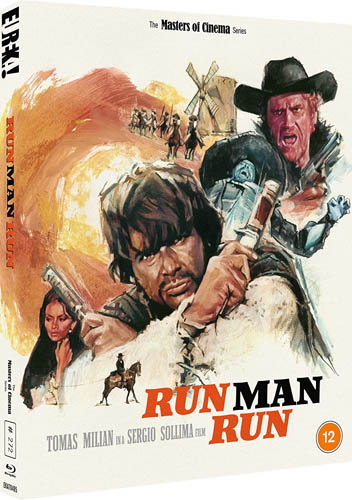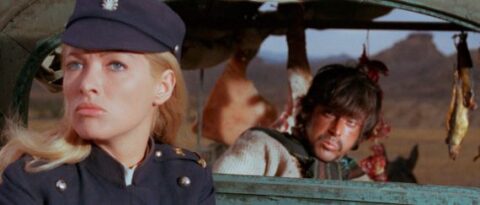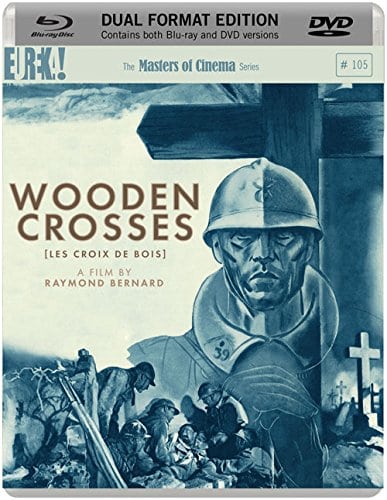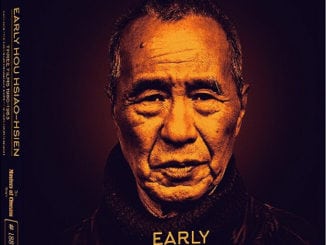Run Man Run (1968)
Directed by: Sergio Sollima
Written by: Pompeo De Angelis, Sergio Sollima
Starring: Donald O'Brien, Linda Veras, Marco Guglielmi, Tomas Milian
ITALY
AKA CORRI UOMO CORRI
AVAILABLE ON BLU-RAY: 23RD JANUARY, from EUREKA ENTERTAINMENT
RUNNING TIME: 120 mins / 85 mins
REVIEWED BY: Dr Lenera

Petty thief and skilled knife thrower Cuchillo returns to his hometown in Mexico, but the local police deem him to he suspicious and throw him into a prison cell with a dangerous desperado, the poet Ramirez. Despite a pardon and release in one day, Ramirez wants Cuchillo to help him escape because of the numerous bounty hunters eager for the price on Ramirez’s head. They make it to Ramirez’s village, but only minutes before the revolutionary bandit Reza arrives. Ramirez is shot but before he dies, he passes information to Cuchillo regarding $3M in hidden gold, and charges him with returning it to revolutionary leader Santillana. Hot on Cuchillo’s trail are two French mercenaries serving President Diaz, Reza and his bandits, an American former sheriff-now-gunslinger Nathaniel Cassidy and Cuchillo’s fiancé, Dolores, who simply wants Cuchillo to stop running and marry her….

It’s always hard not to compare a film to its predecessor if it’s a sequel. Run, Man, Run, Director Sergio Sollima’s entry in the Zapata western [concerning the Mexican revolution] cycle is a sequel to his The Big Gundown, with Thomas Milian’s character Cuchillo returning. However, despite owning the soundtrack as I’m a big Ennio Morricone fan, I haven’t yet seen The Big Gundown [something which I’m soon to rectify with Indicator’s forthcoming Blu-ray release], which is admittedly rather strange seeing as I’ve seen the first of Sollima’s three “spaghetti” westerns Face To Face, and that being a film I rate very highly indeed. Yet it might be a good thing, because I’ll be able to just focus on Run, Man, Run and not keep comparing it to The Big Gundown. It doesn’t seem to be a sequel where one has to have viewed the previous film to understand everything, much like the Dollars trilogy where it doesn’t matter what order you watch the films in unless you want to really get a sense of Sergio Leone’s development as a filmmaker [while chronologically The Good, The Bad And The Ugly actually takes place before A Fistful Of Dollars and For a Few Dollars]. I have no idea of it’s better or worse; critical consensus seems to be that it’s lightly inferior, but there are times when I don’t go along with critical consensus. One thing that surprised me is how unpolitical it is; yes you have the good rebels revolting against the evil government, and the idea that revolutionary ideals are far more important than self, but that’s about it, despite Sollima’s reputation for being political. In any case, I’ll be very surprised if The Big Gundown is an darn fun as Run, Man, Run. Perhaps loosely inspired by The Good, The Bad And The Ugly, the picaresque adventure has various characters set off on the same quest and constantly run into each other and shift loyalties, while its hero, who I believe was previously a supporting character to Lee Van Cleef’s hero, never once uses a gun and constantly has others get the better of him, just blundering through.
The opening does suggest a fiercely political piece which we don’t end up getting. A newspaper headline consisting of the words “Freedom, the fight continues” followed by an announcement by somebody over black and white – with splotches of colour – drawings of masses of people, that he’s going elsewhere to continue the good fight, though I’m not sure who this person is in the film proper, Cuchillo is first seen wandering into a seemingly deserted town, past the corpses of a soldier and those executed for his ‘murder’ He enters a house which seems to be empty, takes some food left on a table, and leaves to be surprised first by the man whose house it is, then a firing squad which he amazingly manages to escape. The tone of the whole piece is set right here; humorous, surprising and action filled. Sollima rarely look slike he was even trying to be exciting, more attempting to push the absurdist elements of many Italian westerns a bit further while avoiding slapstick. Cuchillo enters the busy part of town and is immediately slapped by a woman. She’s Dolores, whom Cuchillo is supposedly engaged to but keeps trying to get away from. She tried to forcibly keep him in her house but he still escaped. She goes to slap him again but then he slaps her and she embraces him. A tumultuous relationship clearly. He gives her a gold medallion that he stole, but the owner shows up to take it back. This is Cassidy, once sheriff but now, realising that society is rotten and if you can’t best ’em join ’em, enjoying being a gunslinger. In a saloon, Cuchillo sees a man stand up and challenge anyone there for a duel. Of course Cassidy obliges, but the intervention of one of Cuchillo’s knives is required when the guy “referring” the showdown is seen pulling out a gun to shoot Cassidy with, in a superbly edited moment. Of course Cassidy had also bet some money for Cassidy to win, but when he runs off with his winnings, suspicious soldiers catch up and throw him into a cell!
Next door to Cassidy, who’s just revealed that he carries knives in not just his shoes but his hair, is famous revolutionary Ramirez who wants to get out of jail right now as some people are after him. Cuchillo helps the both of them to escape, bumping into Dolores who was trying to rescue him, and who is then most unhappy when Cuchillo then leaves again, with his new companion! Ramirez is welcomed as a hero in the town which was his destination, but then three gunmen, the leader being the vicious Reza, turn up and demand that Ramirez tell them where some gold is that he supposedly once hid for them. Ramirez refuses, so Reza has the villagers lined up against a wall and begins to shoot them in probably the film’s darkest scene. But then two other men save the day, leading to a somewhat chaotic [but maybe realistic?] shootout where the dying Reza tells Cuchillo the location of the gold, whereupon Cuchillo immediately rides out for the Texan town of Burton City [a very familiar set]. Following are Reza and a load more men, plus Cassidy, who’s told of the situation by another whom he then shoots in a gun fight. The gold should be rights go to revolutionary Santillana, but also after it are two French [though they don’t sound very French in the English dub] bounty hunters [or should that be “bounty killers”?] hired by the President, while Dolores isn’t interested in getting hold of the gold but very much want to get hold of Cuchillo, so she also sets out for Burton City, and on her own too. Cuchillo sees a woman burying a man, thinking that he’d been shot, though he actually died of an illness. She’s passionate Salvation Army devotee Penny Bannington, who, in the film’s funniest section, “recruits” Cuchillo to be her next “assistant”. She bosses him about and, when she finds him strung up and tortured, chides him about having few clothes on rather than express concern at his predicament.

Penny’s a great character, especially when basic human greed begins to grip her also along with certain other feelings, though this aspect isn’t taken as far as we might expect. However, Run, Man, Run, whose title incidentally is the same name as the main musical theme from The Big Gundown, still provides plenty of violence despite the general humorous approach. The brutality isn’t gloated upon, but blood sometimes makes a startling appearance such as a knife in the throat, while Cuchillo can’t seem to go for more than ten minutes without being beaten, dragged around or strung up. At one point he awakes after being conked on the head to find himself tied to the sail of a windmill, going round in circles and being punched whenever he’s low enough to be reached, though the emphasis is really on the oddness of the situation. There are genuinely funny moments throughout. Cassidy tries to get the piece of paper with the location of the gold on it from Cuchillo by not very nice means, then suddenly Penny, totally innocently, not knowing at all the seriousness of the situation, calls out that she’s found it in her wagon. When Cuchillo is in yet another predicament and things look really bad for him, Penny calls out to God “Send your angel of flames to us”, and deliverance actually does come there and then, though it’s of a different sort than Penny was asking for. Alliances are made and in the end there are only two real sides that people can take, but allegiances can switch, agendas can remain, and do we really trust everyone? After all, this is a film where, despite what Sean Connery’s Jim Malone said in The Untouchables, bringing a knife to a gunfight isn’t always a bad idea. As for the gold though – it’s not ruining things to say that it’s eventually of little importance.
Cuchillo is refreshing after scores of laconic, invincible gun fighters. He may be extremely accurate with his blade throwing, but we believe him when he says “I am a peaceful man man at heart”. The petty thief just wants an easy life, but seems destined to remain unsuccessful and lowly despite his hyperactivity. The always good Thomas Milian plays him broadly, but there are definitely layers to the performance, and we usually know what Cuchillo is thinking at any given time. Despite being played by a Cuban, I imagine that Latino audiences really took to the character, an archetype but not a caricature, after Mexican characters previously being sidelined or over the top, and loved it that Cuchillo was the main lead; Donald O’ Brien as Cassidy is definitely less prominent though he’s an interesting twist on the usual gunfighter character. Cuchillo has clearly met his match in Dolores [he even flinches before she hits him], a formidable woman who will travel a great distance to get what she wants. Maybe this is why we don’t hate Cuchillo for his treatment of her; we sense that Dolores will eventually get him anyway. Peplum temptress Chela Alonso is good as Dolores, but then Linda Veras is downright excellent as Penny in a film which does very well by its two female characters. Most people here are pretending to be what they aren’t, and none are totally good. Sollima’s direction isn’t particularly stylised but there are some splendid compositions which are often deep focus, some amazing shots like a guy falling down dead as we get a flash of the sun behind him, plus some great use of varied landscapes. Guglielmo Mancori’s cinematography is just great throughout. Then there’s Bruno Nicolai’s score which was supposedly really written by Morricone on the sly because he was contracted to only one studio. The main theme, sung in the opening credits, has similar harmonies to a theme which Nicolai composed for The Mercenary, but the two themes for Dolores and Penny [the latter sometimes given appropriate chorale enhancement] and an action theme which has very familiar chord progressions are quite clearly by Morricone.
Run, Man, Run is a tremendously fun piece of work, even though it seems to end very suddenly in the middle of an action scene, with a great deal not resolved. Was Sollima intending another chapter in the adventures of Cuchillo, or was he just telling us that Cuchillo’s life will never change?
Rating: 









SPECIAL FEATURES
Limited Edition slipcase featuring new artwork by Tony Stella
Limited Edition reversible poster
1080p presentation on Blu-ray from a definitive 4K restoration of the original uncut version of the film, with additional colour grading completed exclusively for this release
Eureka’s Blu-rays tend to be of such high quality that it will feel strange to criticise one, but that’s what I’m going to do here. Eureka were saddled with a restoration done by the notorious L’Immagine Ritrovata, who are very good indeed with things like evenness of grain and picture detail, but not so good with colour grading. For quite a while almost any older film that they got their hands on would end up with a strong yellow hue. Eventually they got better, and some films such as Wheels On Meals looked absolutely fabulous. Here however, even though I don’t have access to the original job done by L’Immagine Ritrovata, it’s very clear that this was another botch job, and that Eureka tried to do their best to correct it but there was only so much that they could do with such a flawed product. Why should they have had to try to do this anyway? L’Immagine Ritrovata really need to sort their act out. Run, Man, Run is plagued by inconsistent colours; skies are often a lovely blue but sometimes they’re extremely pale [and not because of cloud] and even sometimes containing some green! Often the blacks don’t look good at all, exhibiting huge crush. At the end of the day these issues shouldn’t hamper one’s enjoyment of the film, but therystill shouldn’t have been there in the first place.
Optional English subtitles, newly translated for this release
Restored English and Italian audio options (original mono presentations)
As usual I watched the film with the English dub. Most actors are speaking English anyway, even if most of them are overdubbed; Milian clearly dubs himself though.
Brand new audio commentary with writers Barry Forshaw and Kim Newman (Uncut Version)
Forshaw and Newman did a fine job on Eureka’s release of Sollima’s Revolver, so I was looking forward to listening to them here. Their track is rarely scene specific and sometimes goes off on tangents, but is full of insight, beginning with the probable reason why Sollima’s reputation isn’t as good as it should be considering the quality of his work; he genre hopped. I could have done without the spoilerific rundown of The Big Gundown, but then again I’m probably the only obtainer of this release who still hasn’t seen it. We’re told that this film was never released in English-speaking territories, only eventually showing up on video in severely shortened state. Forshaw adroitly describes it as being “About films about the revolution rather than the revolution”, while Newman tells us that Sollima, many other directors, and even stars had problems with the method acting, improvisational, Milian. Informative yet exuding enthusiasm, this track is another winner. And you even get to to hear Film Encyclopedia Newman being stumped when asked to name some Italian westerns that had Italian heroes!
Brand new interview with film scholar Stephen Thrower [19 mins]
Thrower perhaps spends too much time detailing Milian’s [admittedly interesting] career , but tells a lovely story of Milian, who while filming Steven Soderbergh’s Traffic, added a strange mutter to his character which was exactly what Federico Fellini did to him when the two of them fell out, and sees his performance here as coming from the Italian Commedia dell’arte tradition.He still gives us a nice look at the film and says how it concerns themes of division that are still pertinent today. Apparently Face To Face didn’t get a US theatrical release either, though he doesn’t mention the UK.
Alternate opening credits
Theatrical Trailer
DISC 2: LIMITED BONUS DISC
“Run, Man, Run” – The Theatrical Cut (85 mins) – the original theatrical release version of the film, presented in 1080p from a 4K restoration with additional colour grading completed exclusively for this release (Limited Edition Exclusive)
I assume that this cut was seen in the cinemas of some countries despite not turning up in the US or the UK, and that its debut wasn’t actually on video. In any case, the distributors really mutilated this film in an effort to speed up a pace they obviously considered too slow. They also removed a lot of the humour, changing the overall tone somewhat, though perhaps the most damaging thing they did was to cut down the very important parts of Linda Veras and Chela Alonso by about two thirds. Gone are Cuchillo’s first scene with Dolores, Dolores and Penny fighting because of Cuchillo, Cuchillo as a member of the Salvation Army, the “angels of death” scene, and a crucial scene where we learn something very interesting about Penny. Due to most of these cuts, the midsection is a bit incoherent. In fact this whole version is one of the worst hack jobs I’ve ever seen that were done on Italian westerns, but kudos to Eureka for still including it; after all, this is the version many people will have seen first.
Brand new audio commentary with author Howard Hughes and filmmaker Richard Knew (Theatrical Version – Limited Edition Exclusive)
I was familiar with Hughes though not Knew, but it wasn’t long before I was enjoying this commentary as much as the other one. The two have a lovely laid back vibe, like two old mates just chatting while watching a film, often asking each other questions, yet still giving us much insight and information; I couldn’t tell that Milian speaks the opening narration and sings the opening song. The two are especially strong on pointing out locations, many of which are admittedly familiar but it’s hard to recall exactly from what. Knew thinks that the windmill scene may have inspired a Duran-Duran video, Hughes points out where the many cuts were made and what they constituted, and they both observe a great deal about the filmmaking style, continuously praising it [and quite rightly so]. I don’t know if Hughes and Knew heard the Newman and Forshow track before doing this one, or indeed vice versa, but there’s almost no repetition between the two.
Reversible sleeve
A collector’s booklet featuring two new essays by Howard Hughes, covering both the film and the “Zapata Western” sub-genre.
Because of L’Immagine Ritrovata’s bizarre ideas about colour grading, I reckon that Eureka’s release of this film won’t be the definitive version of this film to buy. However, “Run, Man, Run” is such a blast that it can still overall be Recommended.





Be the first to comment